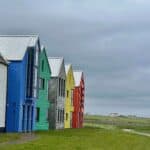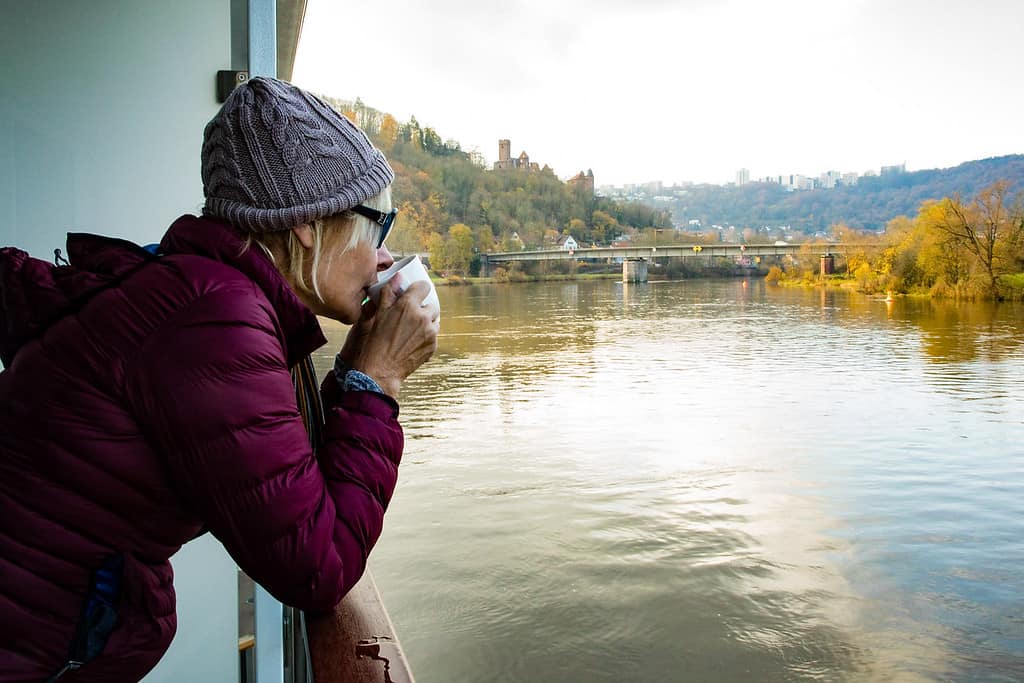Last Updated on June 28, 2025 by Sarah Wilson
Have you ever considered taking an Italian course in Florence and exploring this gorgeous city? Well, I spent a week doing just that.
What To Expect On A One-Week Intensive Italian Course In Florence
In the mornings, I studied Italian on a one-week intensive course at the Leonardo Da Vinci School and in the afternoons, I roamed around Florence and explored the sights. It was a fantastic experience that I can’t wait to share with you.
Now, I know you’re not going to become fluent in any language in a week, but it was fun being back in a classroom. I never thought I’d say that.
Anyway, in this school, only Italian is spoken in class. Those who are new to Italian start with an introductory lesson, which assesses their oral skills and understanding. Everyone else takes a written and oral placement test to determine their suitable level.
I had been teaching myself Italian on Duolingo and Italki for a while, so I was curious to see how well I’d done, and I was surprised and a bit nervous when they placed me in the intermediate class.
There is a maximum of 14 students in a class. There were just ten in mine, and it was a complete mix of ages and nationalities.

The Leonardo da Vinci school is situated in a historical palace in the centre of Florence, just around the corner from the cathedral. Its central location provides easy access to the city’s most beautiful and renowned spots within a short walk.
The lessons take place either in the mornings from 09:00 to 12:15 with a 15-minute break at 10:30 or in the afternoons from 14:15 to 17:30.
I opted for the morning classes, so I had the afternoons free to explore. I loved my early morning walk to the school, stopping for a coffee on the way and watching the locals heading to work before the hoards of tourists invaded the city.
Exploring Florence in the Afternoons
There’s an awful lot to see in Florence, but fortunately, most of the sights are within close walking distance of each other. As each Italian language course starts on a Monday, I’d recommend arriving early and having the weekend to explore as well.
These are my recommendations for what to see in Florence, especially if it’s your first time in this beautiful city.
Start With A Walking Tour

Begin your Florentine experience with a free walking tour; it’s always a great way to get your bearings and learn a little about the city you’re visiting.
There are plenty of free walking tours on offer in Florence. Most free walking tours seem to take place in the morning, but this company also offers afternoon tours.
Florence Cathedral, AKA The Duomo
If you only do one thing in Florence, well, it has to be a visit to the Duomo.
The Florence Cathedral is part of the Monumental Complex of Santa Maria del Fiore, which also includes the Baptistery, Giotto’s Bell Tower, Santa Reparata and the Opera del Duomo Museum. All of these sites are located around the cathedral and can be visited on the same ticket.
For those feeling adventurous and in good shape, climbing the 463 steps to the top of the cathedral’s dome is a must-do. Along the way, you’ll be treated to breathtaking views of the dome’s interior, adorned with stunning frescos depicting the Last Judgement, showcasing scenes of heaven and hell.
From the top of the dome, you get great views of Florence, but if you’re scared of heights, I admit it is a bit scary up there.
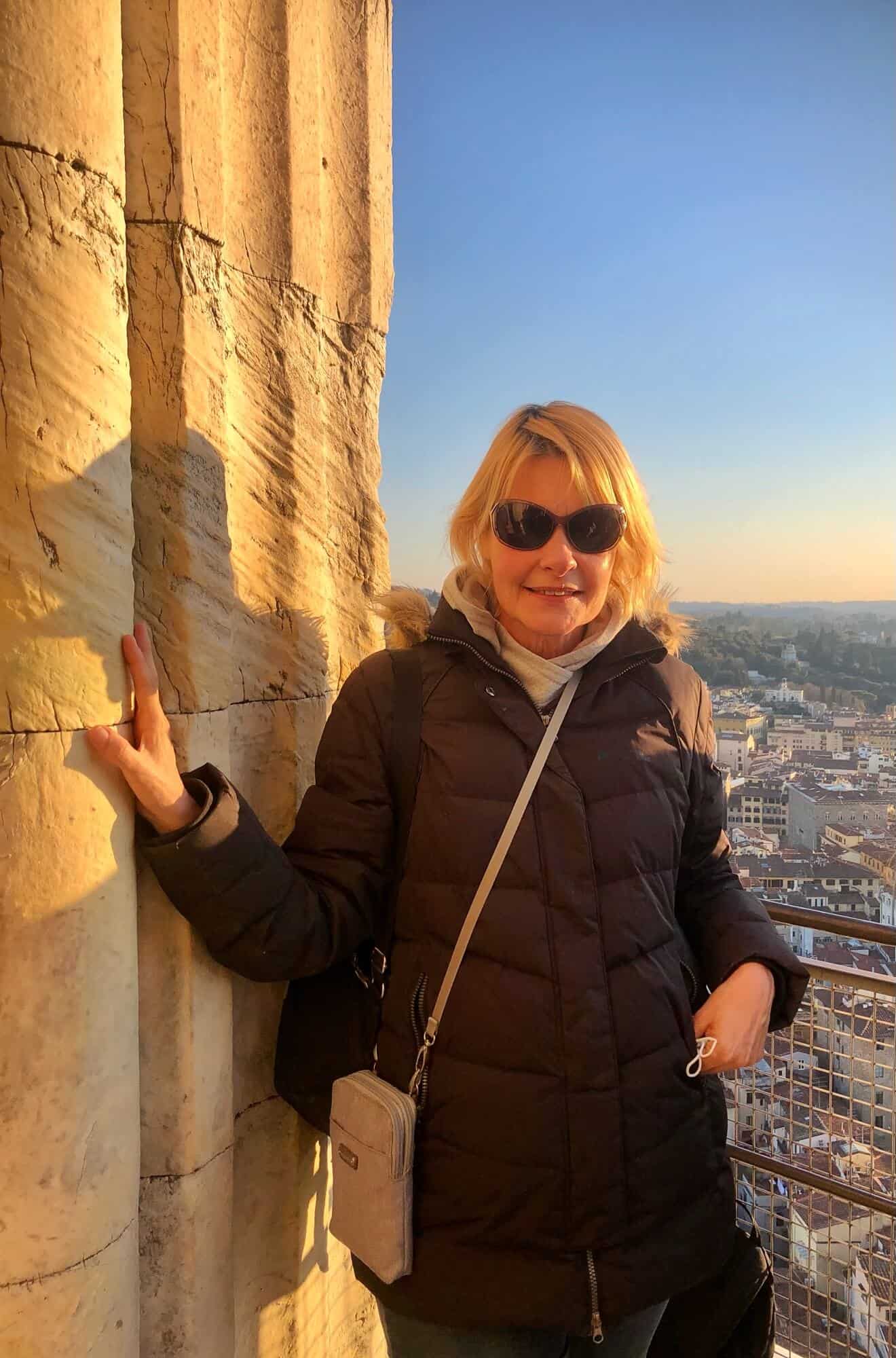
If you plan to climb the dome, you have to make reservations. It’s a popular activity, so book in advance. On the official website, purchase the Brunelleschi Pass and book your time slot. If tickets are sold out for the date, you can try booking with Get Your Guide.
Visit the Baptistery of San Giovanni
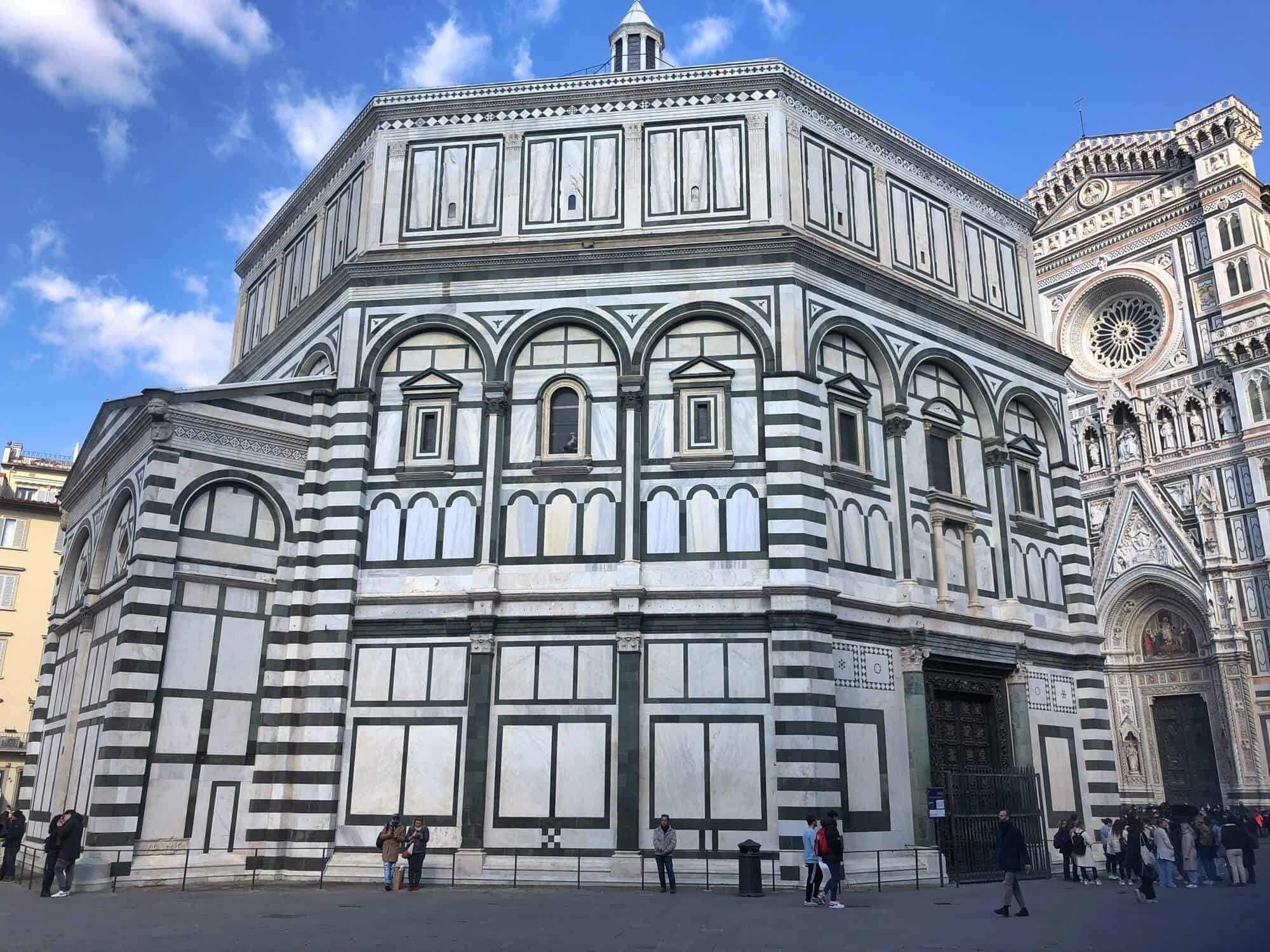
The Baptistery is one of Florence’s oldest buildings. It won’t take you more than 10 to 15 minutes to see it, but it’s definitely worth checking out for its impressive golden mosaic ceiling. Notably, Dante Alighieri and members of the Medici family were baptized in this historic place.
Climb Giotto’s Bell Tower

To get to the top, you climb a series of staircases with several terraces where you can take a break and enjoy a view of the city. I felt far more comfortable climbing these stairs for the view than in the Duomo.
The view is excellent, but at the same time, spoiled by a black mesh that now surrounds the tower. However, you can still get a photo with a smartphone and avoid the mesh.
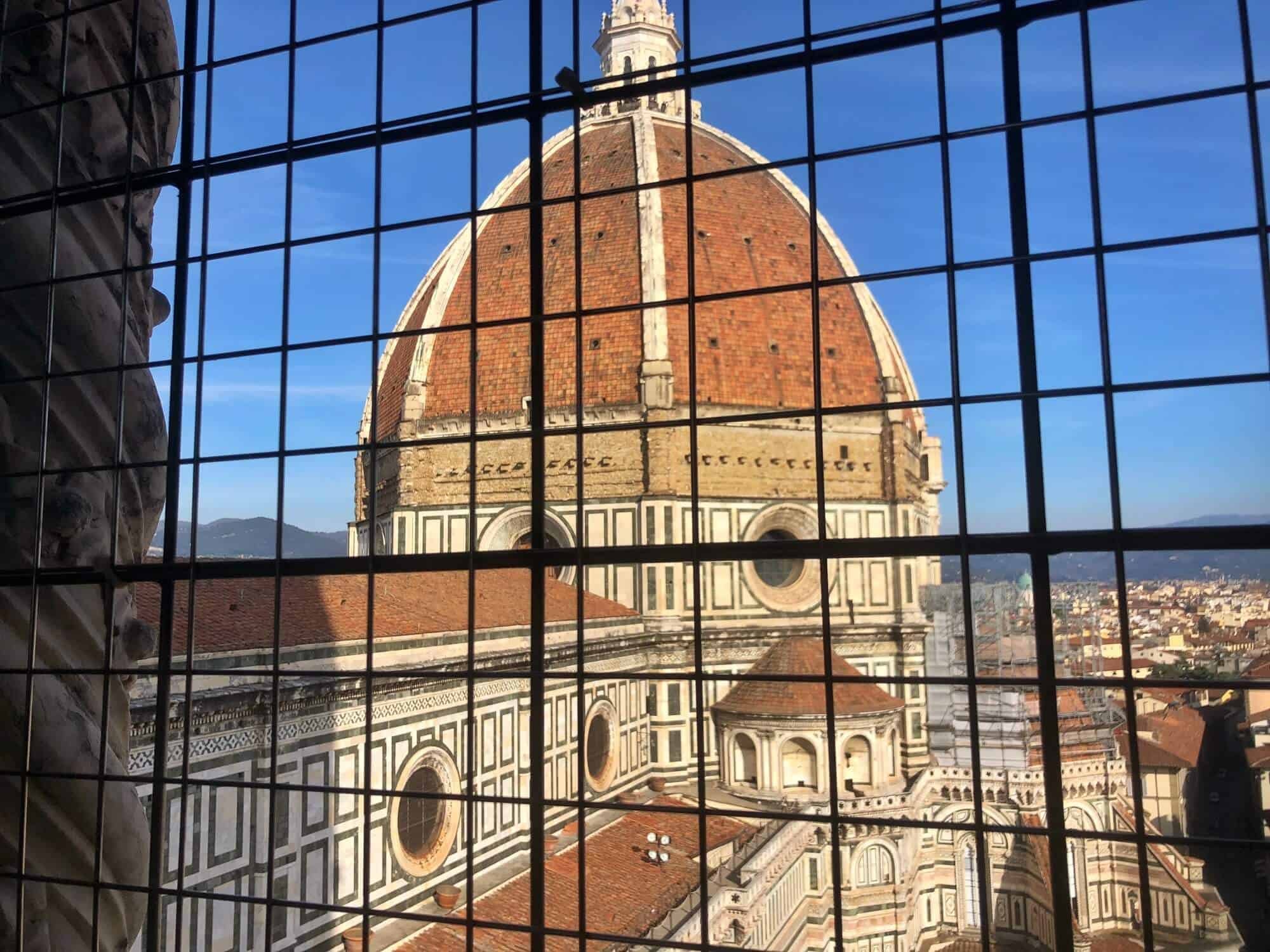
This tower is included in the Brunelleschi Pass and is open daily from morning to early evening.
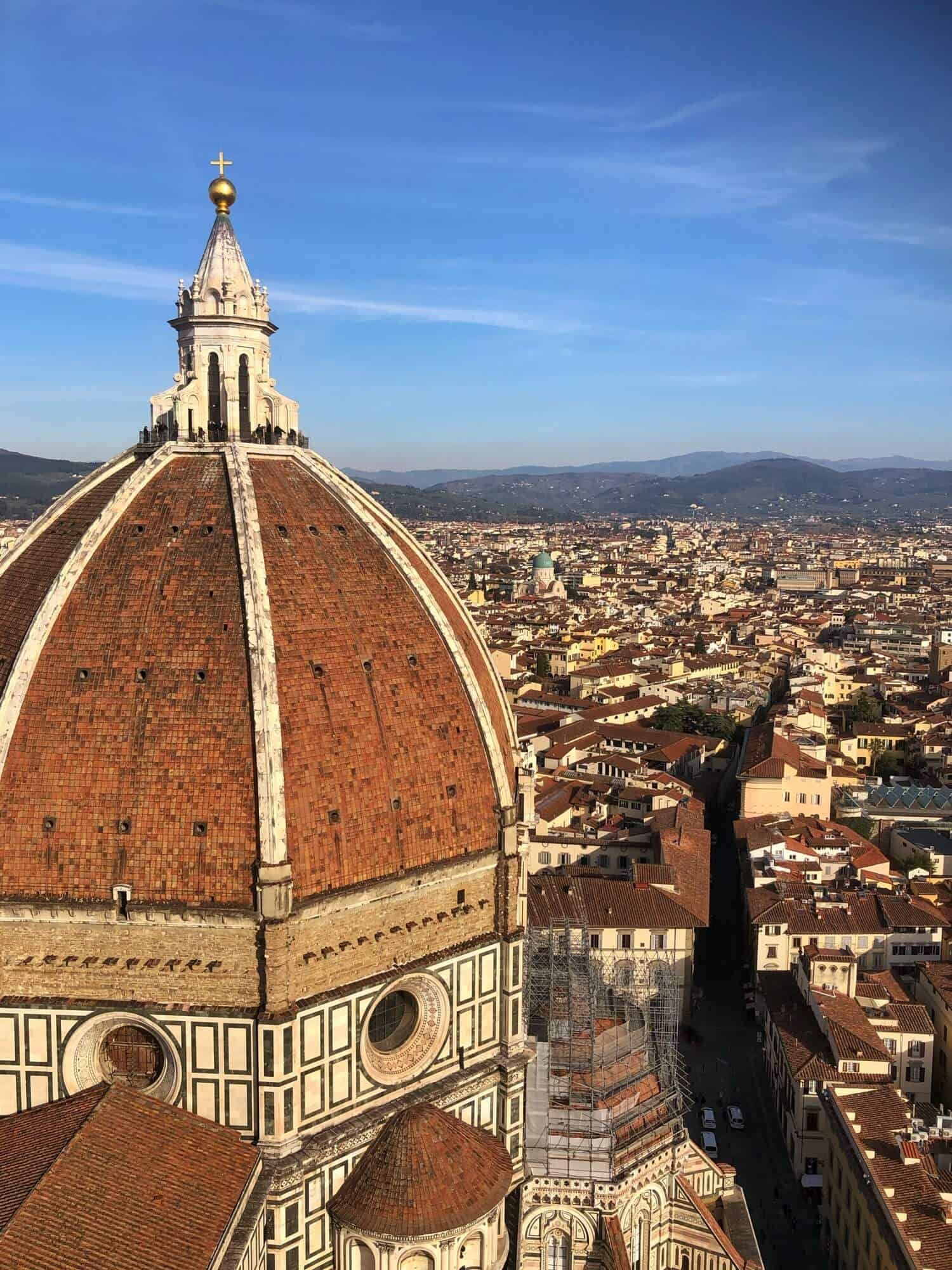
If you are a fan of climbing towers, the view from the tower of Palazzo Vecchio is excellent, too, but I was all towered out by then.
The Uffizi Gallery
The Uffizi Gallery in Florence is one of the world’s most famous museums. It’s located right in the heart of Florence and features artworks by favourite Italian artists like Botticelli and Michelangelo.
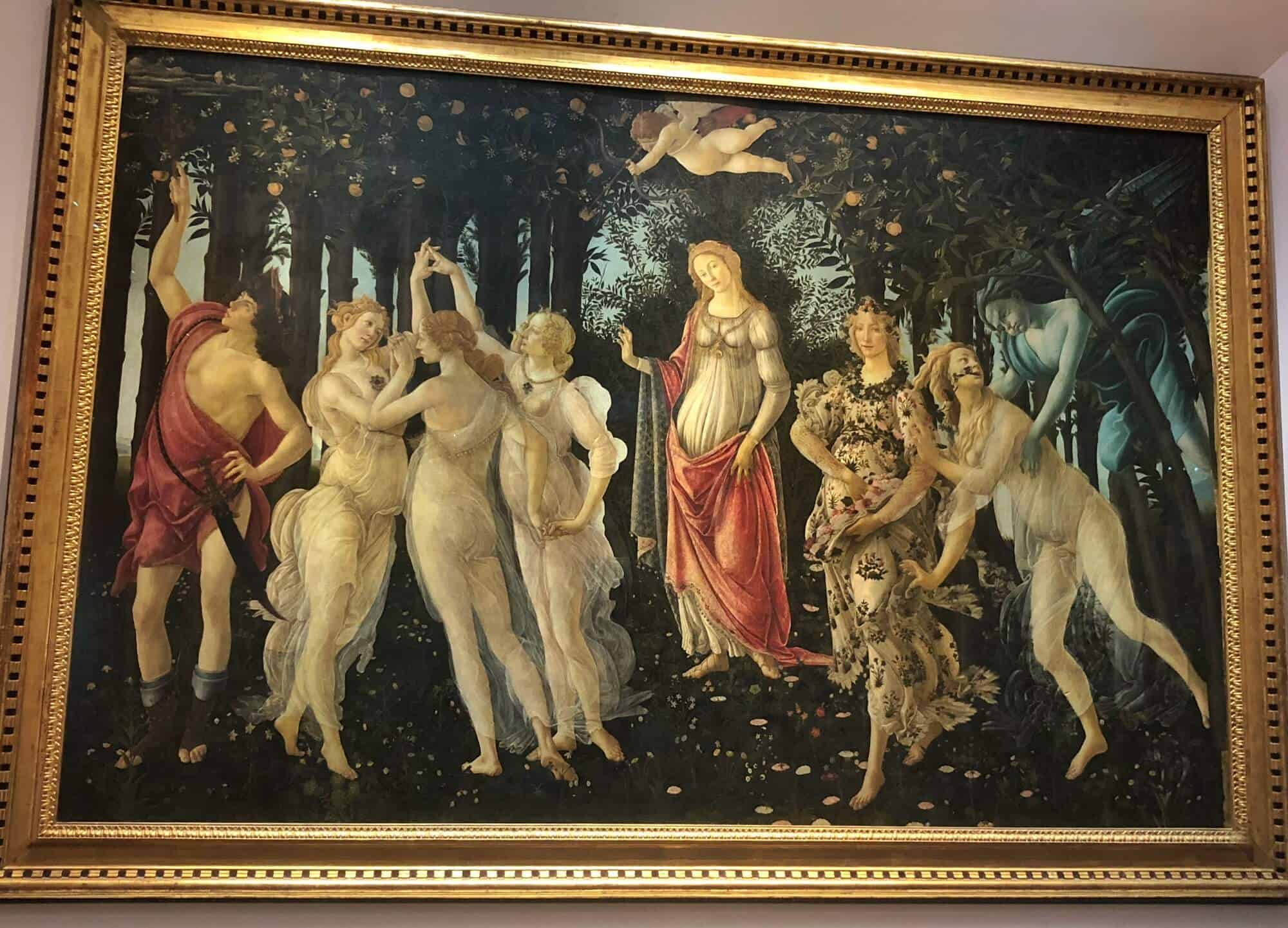
If you’re considering going, getting your tickets early or going for a guided tour to avoid those long lines is a good idea. Even in late February, which I thought would be less crowded, a massive line of people was queueing to get in. So, I booked a slot online and went on a Thursday afternoon, and it was way less hectic.
You can purchase your ticket for the Uffizi Gallery here.
Piazza della Signoria Square
Since the 14th century, the Piazza della Signoria has been Florence’s focal point of political life. The prominent Palazzo Vecchio overlooks this historic square.
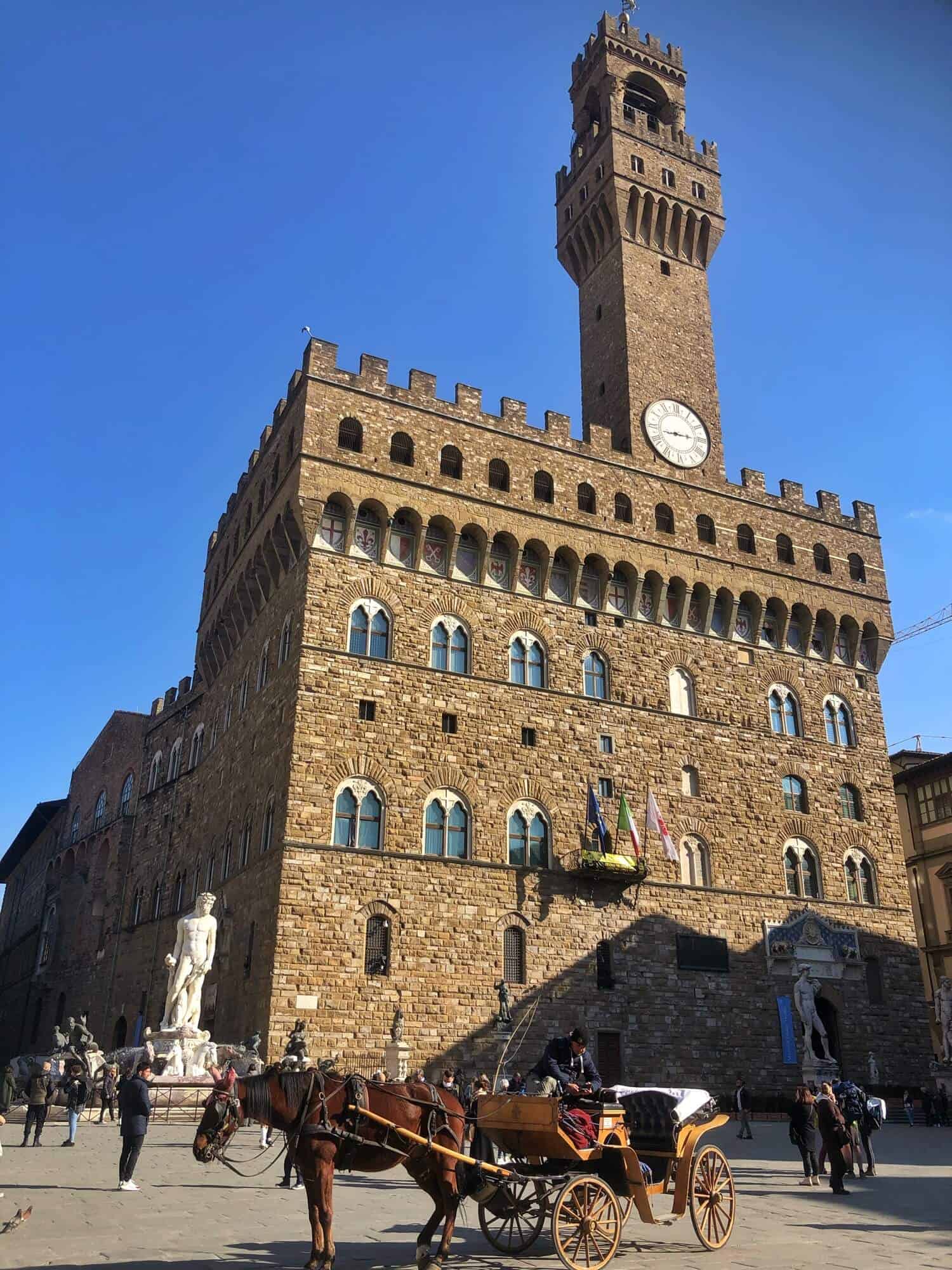
It witnessed significant events, including the triumphant return of the Medici in 1530 and the infamous Bonfire of the Vanities led by Savonarola. The Inquisition denounced Savonarola as a heretic, and he was subsequently burned at the stake in 1498 at this very location, as indicated by a marble circle inscription on the piazza.
The Loggia dei Lanzi
The Loggia dei Lanzi is a pretty outdoor sculpture gallery next to Palazzo Vecchio. It was designed by Orcagna in 1376 and has curved arches that hint at Renaissance style.
One eye-catching sculpture is Benvenuto Cellini’s Perseo holding Medusa’s head, made in 1554, reminding us of what happened to those who opposed the Medici. Another beautiful sculpture there is Giambologna’s Rape of the Sabines, along with many others.
Ponte Vecchio
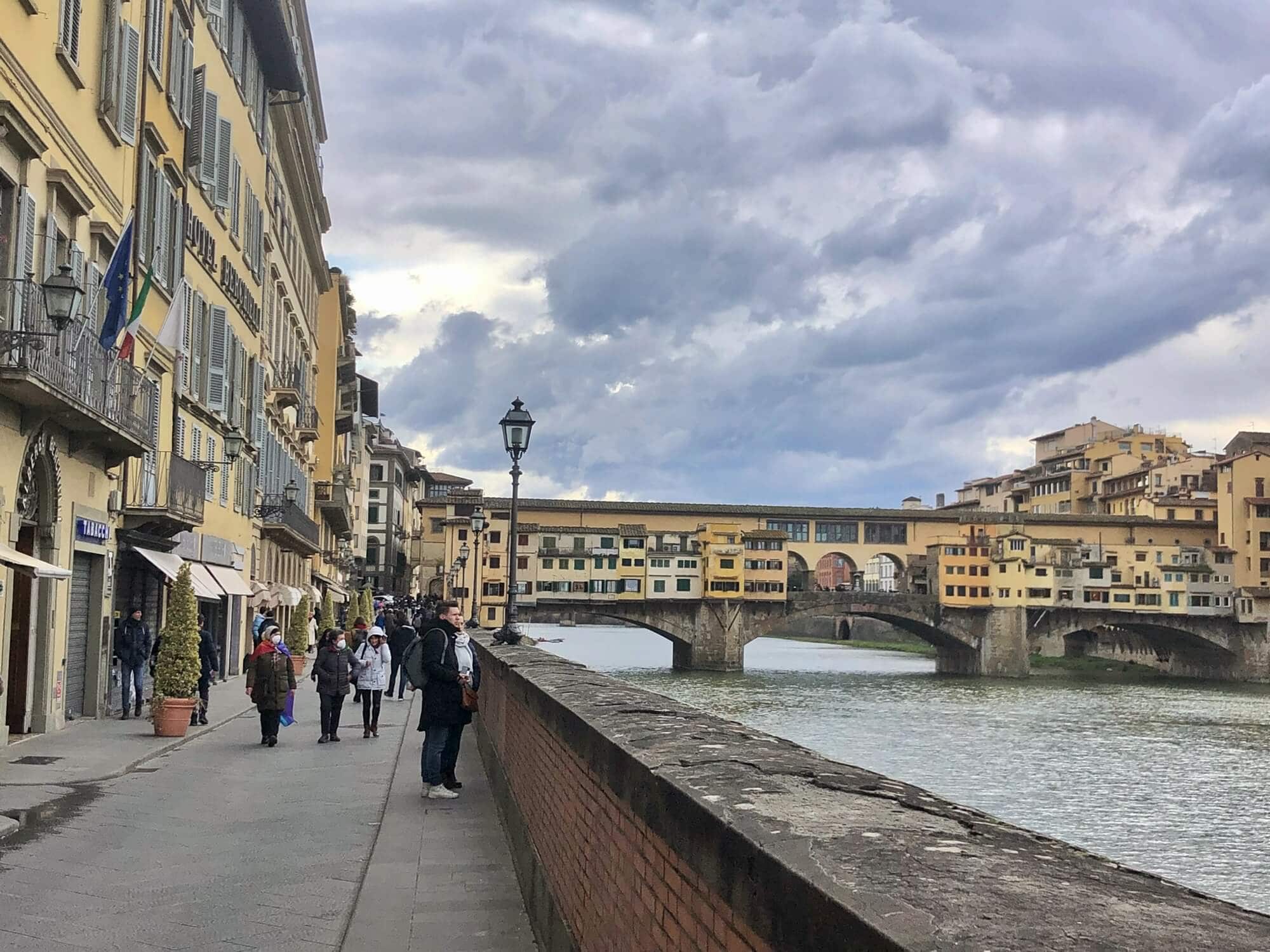
The Ponte Vecchio, also called the Old Bridge, was Florence’s only bridge over the Arno River until 1218. It was rebuilt in 1345 after a flood and miraculously survived World War II. Instead of destroying it, the retreating Germans blocked access by demolishing buildings on each side.
Shops have been on the bridge since the 13th century, including butchers, fishmongers and tanners, creating quite an unpleasant smell due to industrial waste. Later, it became goldsmiths and jewellers, as ordered by Ferdinand I in 1593, to make things smell a bit better for everyone.
It’s a pedestrian bridge and is free to visit. It is open 24 hours a day.
Oltrarno

On a busy Sunday, when crowds of tourists filled the Piazza del Duomo, I thought today would be a good day to visit Oltrano.
Oltrarno, which means “beyond the Arno” in Italian, is one of Florence’s most relaxed and genuine neighbourhoods. Stretching along the southern riverbank of the historic city, Oltrarno has three historic areas—San Niccolò, Santo Spirito, and San Frediano—filled with art galleries, artisan workshops, and beautiful gardens.
The neighbourhood transforms into a lively bar scene and popular outdoor dining spot as evening falls.
What makes Oltrarno unique is its relaxed and stylish atmosphere. Part of this charm comes from the fact that it’s still somewhat undiscovered, especially compared to the more hectic historic centre on the north side of the Arno River.
I crossed the river via the Ponte alla Carraia, and it was like entering a different world.
As I wandered the streets, admiring the homes, I found myself daydreaming, thinking, “I could see myself living here.”
Suddenly, I stumbled upon the Bardini Gardens, and a sign boldly claimed it offered the best view of Florence. Intrigued by such a tempting promise, I couldn’t resist exploring.
Bardini Gardens
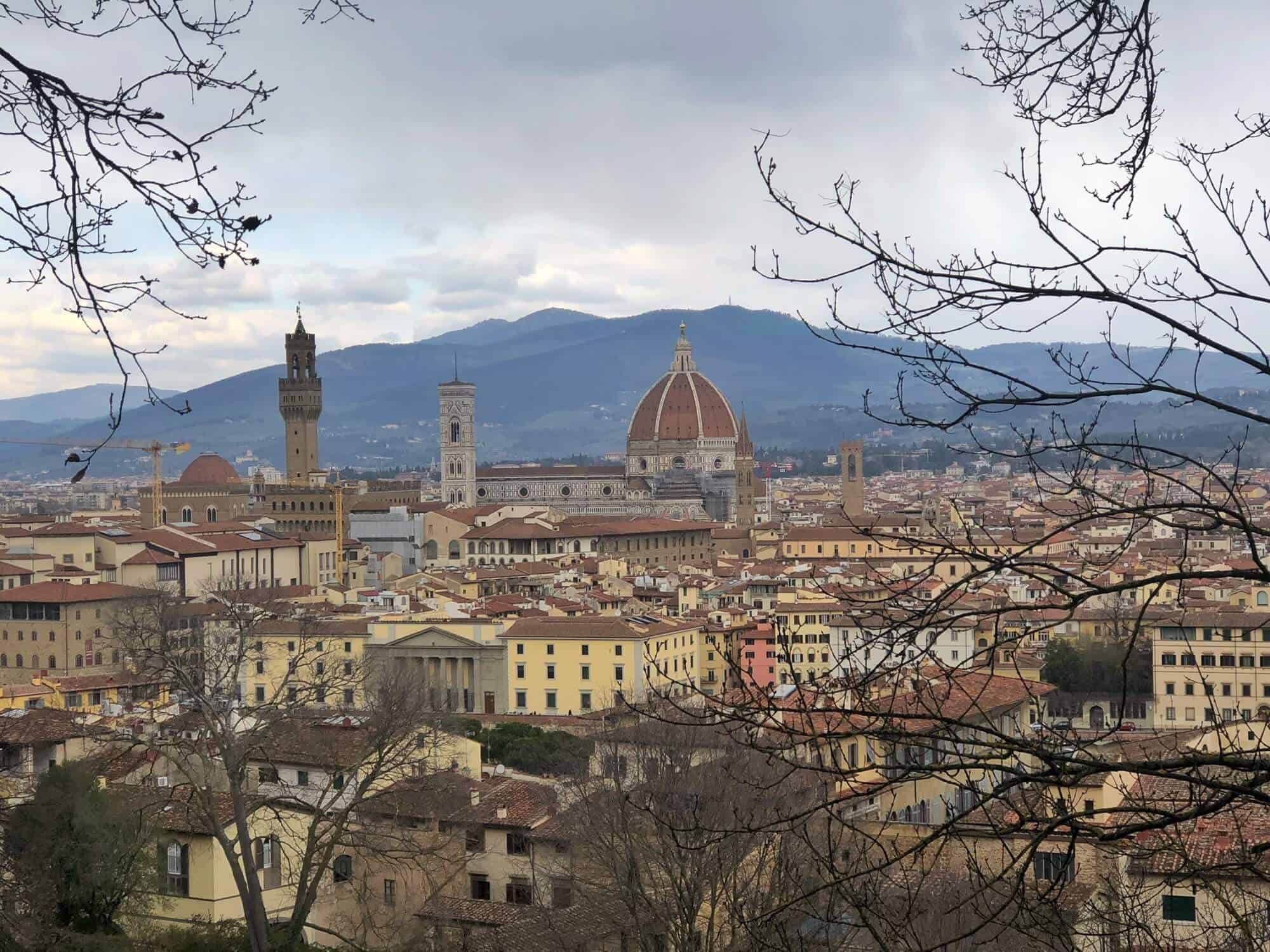
Not widely known and often empty, this 4-hectare garden has recently undergone restoration to bring back some of its original beauty. Now, locals and visitors to Florence are gradually rediscovering it. In just an hour, you can leisurely walk through the entire garden, which is what this tranquil space deserves.
And it was lovely. Admittedly, it would be much prettier when flowers were in bloom, but it provided the perfect haven of peace on a cold Sunday morning in February, and yes, the view was lovely.
The ticket price also included entrance to the more popular Boboli Gardens, so now I had to visit there to get my money’s worth!
Check their website for up-to-date information on opening hours and ticket prices.
Before heading to the other gardens, I continued happily exploring the different neighbourhoods.
The Palazzo Pitti
This massive palace stands as one of Florence’s most prominent architectural landmarks.
Initially constructed in 1457 for the Pitti family, it was designed by Filippo Brunelleschi and built by his student Luca Fancelli. The initial building comprised only the central cube of the current structure (the middle seven windows on the top floor).
In 1549, the property was sold to the Medicis, who used it as the primary residence for the grand ducal family. The palace underwent expansion and modifications, including adding an elegant courtyard and two side wings.
Today, the palace is divided into four museums: the Treasury of the Grand Dukes on the ground floor, the Palatine Gallery and the Imperial and Royal Apartments on the first floor, and the Gallery of Modern Art and the Museum of Costume and Fashion on the second floor.
For opening hours and ticket prices, visit their website or buy your ticket here.
Boboli Gardens

Right behind Pitti Palace, you’ll find the Boboli Gardens. The Medici family designed the layout of these gardens, setting the stage for the Italian garden style that later influenced many European courts.
With its organized layout, this expansive green space is an open-air museum featuring ancient and Renaissance statues. The Gardens also boast grottos and impressive fountains like the Fountain of Neptune.
Piazzale Michelangelo
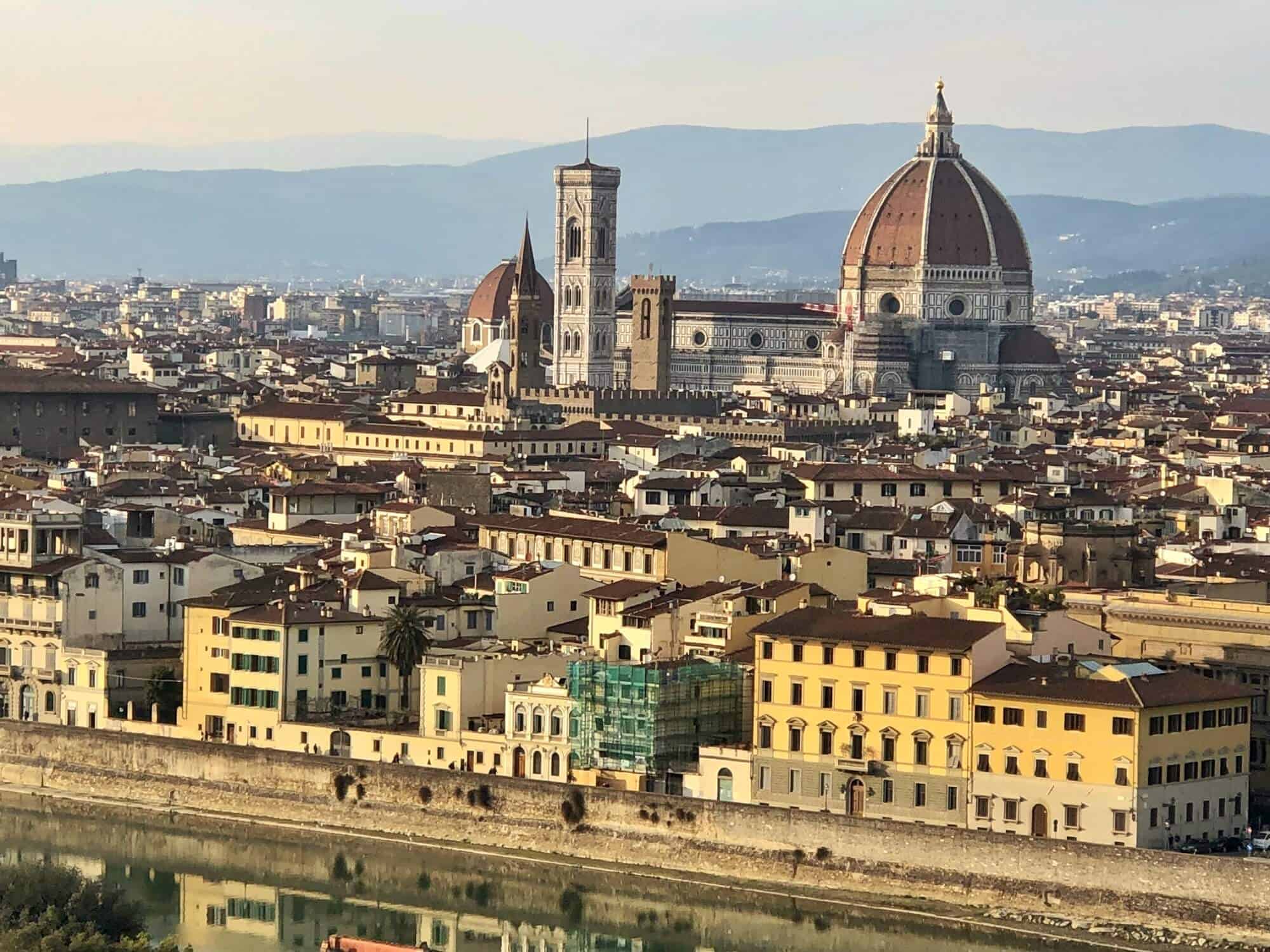
Nowadays, the square is bustling with tourists, vendors, and a bronze copy of Michelangelo’s David (the original is housed at the Accademia Gallery museum).
Renowned for its stunning sunset views, Piazzale Michelangelo is a must-visit spot. You can easily get there on foot, or take the bus (12 or 13 from the city centre).
Take a Chianti Wine Tour
I do enjoy sampling the local wines, so I went on a half-day tour from Florence to visit two wineries in the beautiful Chianti Hills. It was a fun experience where I met the local winemakers, took a leisurely stroll through the vineyards, and sampled various local wines and products. The wines, especially at the second winery, were absolutely fabulous.
However, I was surprised by the larger-than-expected group size—it turned out to be a whole bus load. I hadn’t anticipated so many people on a Monday afternoon in February, having expected something more akin to a smaller wine tour I had taken in Verona. Despite the initial surprise, the event turned into quite a social affair once everyone had the chance to try a couple of wines.
This is the wine tour I took.
The Pros & Cons Of Studying Italian In Florence
Pros:
Well, the obvious one is Florence, which is a magnificent city to explore. So, what a great place to combine language acquisition with exploring a beautiful and historically significant city.
Florence boasts many reputable language schools that specialize in short-term intensive courses. I took classes at the Leonardo Da Vinci School. I loved it and plan to do another intensive course with them in one of their other schools – probably Turin.
Quick Immersion: A week-long intensive course allows you to immerse yourself in Italian without a long-term commitment, making it ideal for a holiday experience.
Cons:
Because Florence is such a beautiful city, it attracts many tourists. In the centre of Florence, I think I heard the American accent more often than the Italian one. With so many foreigners visiting the city, the go-to language at all the main sights, cafes, and restaurants was English, which made having an authentic Italian conversation a little bit harder.
Limited Language Progress: While you can gain valuable language exposure, a week is a short time for significant language progress.
Cost Considerations: Intensive courses can be relatively expensive, and you might question the value for such a short duration compared to longer-term programmes.
However, combining Italian classes with exploring the sights of Florence was a fun and fulfilling experience for me.
And as class finished at Friday lunchtime, I collected my certificate, waved goodbye to my fellow students and headed to the train station. Bologna beckoned.
For More Posts On Italy, Check These Out
Check out these posts for other amazing places to visit around Italy.
One Perfect Day In Locorotondo
One Day in Polignano a Mare, Puglia
Best Things To Do In Sestri Levante
Spello, A Gorgeous Town in Umbria
Ortisei Italy – A Great Base For Exploring The Dolomites
Best Towns and Villages in Umbria
Exploring Orvieto – A Fabulous And Easy Day Trip From Rome By Train
How To Spend One Full Day In Bologna
Why You Should Visit Ferrara – An Easy Day Trip From Bologna
Varenna- The Perfect Base For Exploring Lake Como
How To Spend One Full Day (and a little bit) In Milan
Four Really Easy Day Trips From Rome By Train
Diary Of A Solo Traveller On A Viking Ocean Cruise From Barcelona To Rome
Two Week Full Immersion Italian in Agnone
For More Posts On Learning A Language Overseas, Check These Out
Two Week Full Immersion Italian in Agnone
Save This Pin For Later
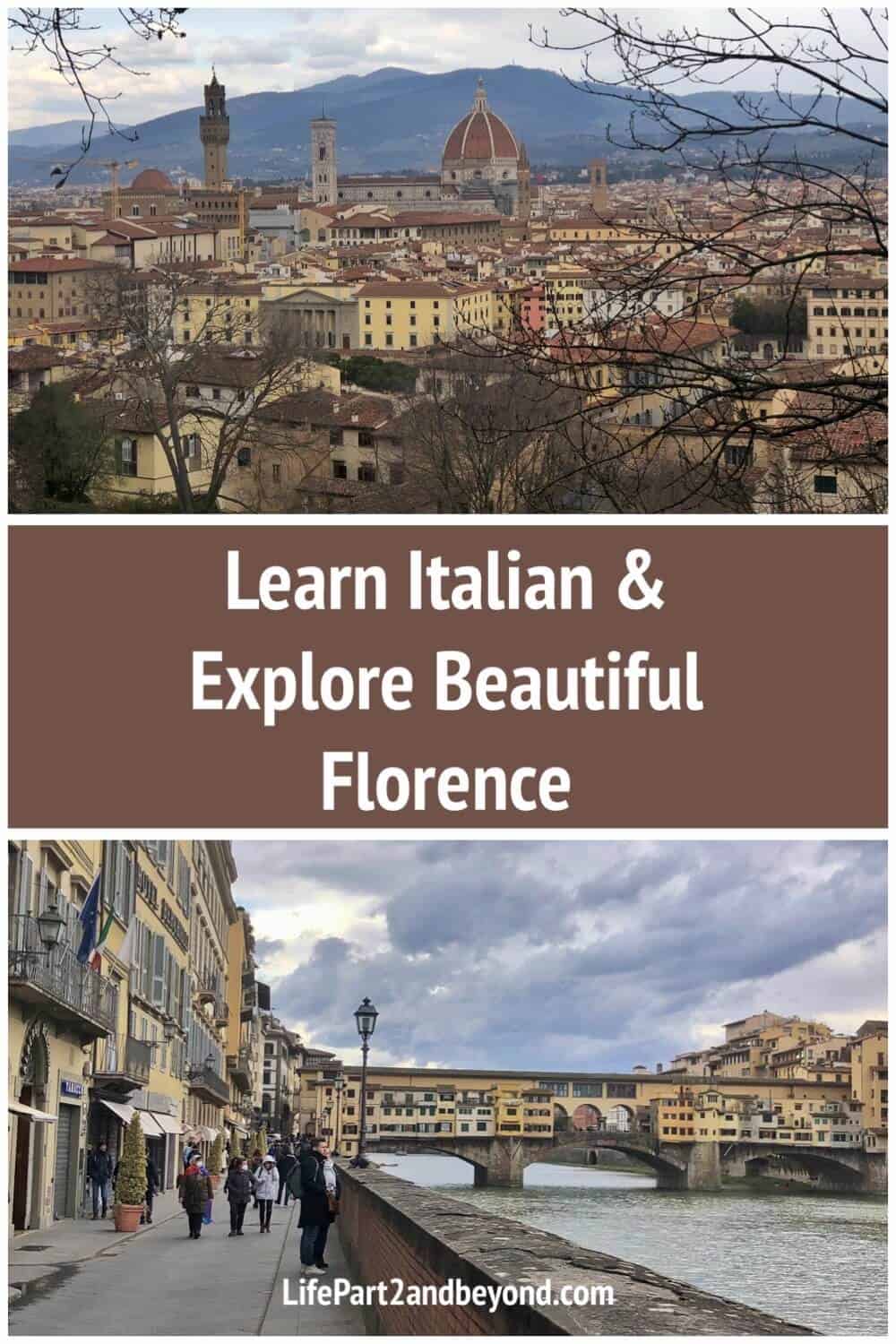
Disclaimer:Some of the links on this website are “affiliate links”, meaning that if you click on the link and make a purchase, I will receive a small commission at no extra cost. This helps me to keep my website running and continue to share my travelling knowledge with you. Thank you for using the links on my website.




